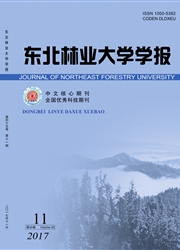

 中文摘要:
中文摘要:
为了探讨竹笋快速高生长与母竹之间的养分输导关系,揭示毛竹快速生长内在规律,试验测定了竹笋快速生长期内不同竹龄器官(叶、枝、秆、蔸根)的主要养分质量分数、冠层(上层、中层和下层)水势、地上器官(叶、枝、秆)的生物量,与同样地同期小年期母竹测得值做比较。结果表明:在竹笋快速生长期,氮元素在母竹叶片中先下降后上升,而蔸根中则先略有升高然后趋于稳定;在叶中,钾元素随竹笋快速生长而迅速升高,而在蔸根中始终保持稳定状态;磷在叶片和蔸根的质量分数均较低。同小年期相比,氮元素在叶、枝、秆、蔸根中的质量分数均较低;磷元素在叶、蔸根的质量分数较低,而在枝、秆中其质量分数要高;钾元素在叶、秆、蔸根中的质量分数高,但在枝中低。在竹笋的快速生长期,各竹龄叶的水势变化总体呈"V"型曲线,从3月中旬到5月中旬,水势有变小趋势,随后有所回升。同小年期相比,林冠各层的水势均大于同期的小年期;在竹笋快速生长期,母竹地上各器官生物量占比相对稳定。同小年期相比,光合器官竹叶生物量占地上器官生物量的7.05%,增加了31.90%。因此,竹笋的快速生长对母竹产生了影响,在快速生长期,母竹通过营养元素的迁移、地上生物量格局的分配,为竹笋的快速生长提供了可能。
 英文摘要:
英文摘要:
The experiment was conducted to study the relationship between the rapid growth of bamboo shoots and nutrient transport between mother bamboos, and reveal the inherent law of rapid growth of bamboo. The main nutrient content, water po tential of canopy and biomass of aboveground organs were measured in different growth stages of bamboo shoots during the fast growth period, and compared with the corresponding value mother bamboo in the same period. In the rapid growth period of bamboo shoots, N content in the leaves of the mother bamboo decreased first and then increased, but in the root, it increased first and then stabilized, K increased rapidly with the rapid growth of bamboo shoots, and remained stable in the roots, P in leaves and roots were low. Compared with the off-year period, the contents of N in leaves, branches, culms and roots were lower, the contents of P in leaves and roots were lower, while those in branches and culms were higher, and K in leaves, culms and roots was higher, but lower in branches. During the rapid growth period of bamboo shoots, the leaf water potential of each bamboo age showed a "V"-shaped curve. From mid-March to mid-May, the water potential became smaller and then picked up. Compared with the off-year period, the water potential of canopy layers was greater than that in the off-year period. During the rapid growth period of bamboo shoots, the biomass of the organs on the ground was relatively stable. Compared with the off-year period, bamboo biomass accounted for 7.05% of the aboveground organs biomass, in- creased by 31.9%. Therefore, the rapid growth of bamboo shoots had an important impact on the mother bamboo, and the rapid growth of bamboo shoots had an effect on the mother bamboo. In the rapid growth period, the distribution of nutrients and the allocation of aboveground biomass provided the rapid growth of bamboo shoots.
 同期刊论文项目
同期刊论文项目
 同项目期刊论文
同项目期刊论文
 期刊信息
期刊信息
